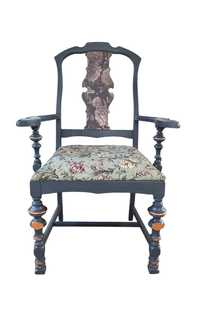The symbolic, political, and religious power of chairs is revealed in Oaxaca.

The symbolic, political, and religious power of chairs is revealed in Oaxaca.
Daniel López Aguilar
La Jornada Newspaper, Thursday, July 17, 2025, p. 5
Among the objects that are part of everyday life, few hold as much memory as a chair. They are silent witnesses that bear the weight of time, conversations, and silences.
This symbolic charge is the focus of SillArte , an exhibition of 13 pieces created by the creative duo Max Sanz and his wife, Guadalupe Pérez Morales. The exhibition is being held at the Hotel Casa Cantera in downtown Oaxaca.
They have a symbolic, political and religious power that has always accompanied them
, Sanz explained in an interview with La Jornada .
The choice of chair also has a practical aspect. Buying one is very simple. We wanted it to remain functional and decorative at the same time.
Each work combines techniques that emphasize its uniqueness: gold leaf, liquid glass, PVC tapestry, liquid bronze, toning agents, Judean bitumen, and crackle. It's not just about beautifying them, but also about highlighting the history of those who designed, used, and preserved them.
The project was born almost by chance after several conversations with a workshop that rescues antique pieces brought from the United States. One day, we told them we had refurbished a family object, and that's where the idea of displaying the pieces came from
, the Oaxacan artist recalled.
The complicity between Sanz (Natividad, Oaxaca, 1992) and Pérez Morales is another cornerstone of the project. "Two heads are better than one. We share a passion for decoration, which we studied together
," he commented.
"Within the duo, I'm more in charge of the technical and visual aspects, while Guadalupe brings a more sensitive perspective that gives character to each work. We understand each other because we speak the same creative language, although each of us has our own style."

▲ Piece renovated by Max Sanz and Guadalupe Pérez Morales and included in the SillArte exhibition. Photo courtesy of Sanz
Rather than erasing the traces of the past, we sought to keep them alive. We wanted to recover the moment in which they were created, the designs conceived for the fashion and comfort of that era
, he emphasized.
The montage invites you to awaken memories: a family room, your grandparents' house, a movie scene.
These pieces of furniture have always been associated with those who valued detail and quality. Rather than repeating baroque or classical tapestry, we transformed them with contemporary colors and textures
, the artist added.
Restoring and transforming old furniture helped reduce tree felling and prevented it from ending up as trash that takes centuries to decompose, she explained. It was also a sensible economic decision: it's better to invest in something that lasts rather than something disposable
.
For Sanz, the Oaxacan setting gave meaning and nuance to the project. "Here, art is felt in the looms, the clay, the alebrijes... We reclaimed that identity to apply it to pieces that continue to be part of daily life."
We want the public to remember that behind every creation there was someone who thought it through, chose materials and shapes, and who still has something to say today. Chairs hold more than bodies: they hold memories, glances, and even what's left unsaid
, he concluded.
With free admission, SillArte can be visited at the Hotel Casa Cantera (Privada de Reforma 103, Centro neighborhood, Oaxaca).
jornada




